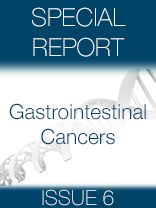Patient Populations Provide Sequencing Clues in Chemorefractory CRC
To gain further insight into TAS-102 and regorafenib, Targeted Oncology spoke with Tanios Bekaii-Saab, MD, on how he utilizes currently available data to provide optimal care for patients with chemorefractory CRC.
TAS-102 and regorafenib

Tanios Bekaii-Saab, MD
Treating patients with chemorefractory advanced colorectal cancer (CRC) has undergone a significant transformation in recent years, with the approvals of regorafenib (Stivarga) in September 2012 and TAS-102 (Lonsurf) in September 2015. Now, with two agents approved, the optimal sequence for these therapies becomes the next relevant question.
In the pivotal phase III CORRECT study, regorafenib improved overall survival (OS) by 6.4 months compared with 5.0 months with placebo (HR, 0.77; 95% CI, 0.64-0.94). Furthermore, progression-free survival (PFS) was 2.0 months with regorafenib versus 1.7 months with placebo (HR, 0.49; 95% CI, 0.42-0.58).
In the pivotal phase III RECOURSE trial, median OS with TAS-102 was 7.1 months compared with 5.3 months with placebo (HR, 0.68;P<.0001). Median PFS in the TAS-102 arm was 2.0 months versus 1.7 months with placebo (HR, 0.48;P<.0001).
To gain further insight into an optimal sequence for these two agentsTargeted Oncologyspoke with Tanios Bekaii-Saab, MD, associate professor, Department of Internal Medicine, The Ohio State University Comprehensive Cancer Center, on how he utilizes currently available data to provide optimal care for patients with chemorefractory CRC.
TARGETED ONCOLOGY:How would you recommend sequencing regorafenib with TAS-102?
BEKAII-SAAB:
We have more than one option, which is a good problem to have. To get an idea of how to sequence these therapies, you can look at the phase III data from the two studies that led to the approvals for the targeted agent regorafenib and cytotoxic TAS-102. The RECOURSE study looking at TAS-102 had about 15% to 20% of patients who had prior regorafenib. The CORRECT study looking at regorafenib was before TAS-102 approval.
From a practical purpose standpoint right now, and the way we are doing it in clinic, is after you get to the third- or fourth-line of therapy, we introduce regorafenib first. Once a patient progresses, then we can administer TAS-102.
There are some exceptions. Let’s say a patient has significant liver function abnormalities or significant hand and foot syndrome from prior capecitabine, then we would consider moving TAS-102 ahead of regorafenib. There are also other instances where a patient may have significant bone marrow toxicities from prior therapy, and those patients would be less of a candidate for TAS-102 before regorafenib.
For practical purposes right now, and to follow the spirit of the trials, we are going with regorafenib first and TAS-102 second.
TARGETED ONCOLOGY:What types of responses are typically seen with regorafenib and TAS-102?
BEKAII-SAAB:
Both regorafenib and TAS-102, because of their placement, you won’t have actual response. You do have tumor shrinkage, although that does not qualify as a partial response by RECIST criteria, but you still see drops in the cancer markers.
There is a very interesting study with regorafenib as a follow up to the CORRECT trial. This trial took 108 patients from the CORRECT trial, which was regorafenib versus placebo, who only had lung metastases. There was an interesting phenomenon that was observed, which was that when you look at the tumors within the lung, they tend to cavitate. What that means is that you’re essentially killing cancer cells from within, without changing the size of the tumor. Theoretically that is what we think that means.
If patients have lung cavitations, they tend to have tumor shrinkage, they tend to live longer, and they tend to have better PFS. So there is an effect on the tumor, it’s just not as much shrinkage as cavitation and stabilization of disease.
TARGETED ONCOLOGY:With regorafenib specifically, what are potential dosing strategies to combat adverse events?
BEKAII-SAAB:
If you take 100 patients receiving regorafenib and give them the dose that is approved by the FDA, which is 160 mg, 20% of those patients will maintain that dose throughout their course. The rest of those patients will have to go down to 120 mg and some will even have to go down to 80 mg, which is the lowest dose acceptable to move forward with.
There are a lot of different dosing strategies going around without any validated data. Some folks start with 120 mg, some start with 80 mg and go up, and some do an alternating strategy of one week on and one week off. The alternating strategy, in my opinion, is probably the least effective because you lose that antiangiogenic pressure. I would rather just give regorafenib continuously.
Giving regorafenib at a lower dose, like 120 mg or 80 mg, are acceptable strategies. The problem is that we do not have data that supports starting at a lower dose and then escalating. The good news is that we have a study now, called REDOS that is accruing 120 patients to look at two dosing strategies. One is the standard dosing strategy at 160 mg and the other one is starting at 80 mg and then going up every week to 120 mg and then 160 mg. We are hoping to capture the right dose with the escalating dosing strategy.
We should hopefully have a readout from REDOS by the end of the year, and that might help us understand more on how to optimize the dosing of regorafenib.

Savona Discusses First-Line JAK Inhibition for Patients With Myelofibrosis at Risk of Anemia
April 17th 2024During a Case-Based Roundtable® event, Michael Savona, MD, and participants discussed the case of a patient with myelofibrosis and moderate anemia receiving JAK inhibitor therapy.
Read More